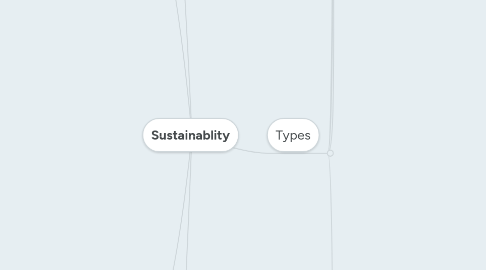
1. Aspects
1.1. Economic
1.1.1. Consistent, Profitable Growth
1.1.2. Risk Management
1.1.3. Total Shareholder Return
1.2. Social
1.2.1. Respect for the Individual
1.2.2. Equality Opportunity
1.2.3. Diversity
1.2.4. Outreach Programmes
1.2.5. Human Rights
1.3. Enviromental
1.3.1. Permit & License Compliance
1.3.2. Emissions to Air
1.3.3. Water/ Chemical Usage & Discharge
1.3.4. Bio-diversity Management
2. How
2.1. Sustainable Design
2.1.1. Environmental Engineering
2.1.2. Green Engineering
2.1.2.1. 12 Principles
2.1.2.1.1. 1. Non-hazardous input & output
2.1.2.1.2. 2. Prevent waste
2.1.2.1.3. 3. Seperations & purifications operations
2.1.2.1.4. 4. Maximize mass,energy and temporal efficiency
2.1.2.1.5. 5. Output pulled > input pushed
2.1.2.1.6. 6. Embedded entropy and complexity viewed as an investment
2.1.2.1.7. 7. Durability not immortality
2.1.2.1.8. 8. Design flaw = unnecessary capacity/capability
2.1.2.1.9. 9. Minimize material diversity
2.1.2.1.10. 10. Include integration of interconnectivity
2.1.2.1.11. 11. Include designing for performance
2.1.2.1.12. 12. Based on renewable and readily available inputs
3. Impact
3.1. Climate Change
3.1.1. Evidence
3.1.1.1. Direct
3.1.1.1.1. Rise of Land and Ocean Temperatures
3.1.1.1.2. Rise of Sea Levels
3.1.1.1.3. Higher green gas concentration
3.1.1.2. Indirect
3.1.1.2.1. Spring comes earlier
3.1.1.2.2. Species migrating poleward and upward
3.1.1.2.3. Tree-lines shifting polewards and upwards
3.1.2. Natural Driver
3.1.2.1. Solar irradiance stabile (stabile), Temperature still Increase
3.1.2.2. Sunspot activity decline (cooling), Temperature still Increase
3.1.2.3. More Volcanic Activities (cooling), Temperature still Increase
3.1.3. Impacts
3.1.3.1. Health
3.1.3.1.1. Weather related mortality
3.1.3.1.2. Infectious diseases
3.1.3.1.3. Air-quality respiratory illness
3.1.3.2. Agriculture
3.1.3.2.1. Falling crop yields
3.1.3.2.2. Irrigation demands
3.1.3.3. Forest
3.1.3.3.1. Less forest composition
3.1.3.3.2. Geographic range of forest decline
3.1.3.3.3. Forest health and productivity decline
3.1.3.4. Water Resources
3.1.3.4.1. Water supply (decline)
3.1.3.4.2. Water quality (decline)
3.1.3.4.3. Competition of water
3.1.3.5. Coastal Areas
3.1.3.5.1. Erosion of beaches
3.1.3.5.2. Inundation of coastal lands
3.1.3.5.3. Additional cost to protect coastal communities
3.1.3.6. Species and Natural Areas
3.1.3.6.1. Lost of habitat and species
3.1.3.6.2. Cyrosphere : diminishing glaciers
3.1.4. What can we do?
3.1.4.1. Change our behavior
3.1.4.1.1. Awareness (education)
3.1.4.1.2. Acknowledgement
3.1.4.1.3. Action
3.1.4.2. Change technology
3.1.4.2.1. Improve energy efficiency
3.1.4.2.2. Reduce waste
3.1.4.2.3. Use recycled contents in new products
3.1.4.2.4. Eliminate toxic components
3.1.4.3. Change the fuel
4. Engineers Role
4.1. Sustainable Engineering Design Criteria
4.1.1. Impact on people (society)
4.1.2. Impact on the planet (environment)
4.2. Traditional Engineering Design Criteria
4.2.1. Function
4.2.2. Cost
4.2.3. Safety
5. Types
5.1. Sustainable Energy
5.1.1. Total Gas Produced
5.1.1.1. Carbon Dioxide ( 77%)
5.1.1.1.1. Electricity and Heat
5.1.1.1.2. Land use change
5.1.1.1.3. Transportation
5.1.1.2. Methane (14%)
5.1.1.2.1. Agriculture
5.1.1.2.2. Waste
5.1.1.3. Nitrous Oxide (8%)
5.1.1.3.1. Agriculture
5.1.2. Energy Used
5.1.2.1. Petroleum
5.1.2.2. Coal
5.1.2.3. Natural Gas
5.1.2.4. Cement Production
5.1.3. Types
5.1.3.1. Renewable
5.1.3.1.1. Biomass energy
5.1.3.1.2. Wind energy
5.1.3.1.3. Ocean energy
5.1.3.1.4. Hydropower energy
5.1.3.1.5. Solar energy
5.1.3.1.6. Geothermal energy
5.1.4. Efficiency
5.1.4.1. Households
5.1.4.2. Commercial Building
5.1.4.3. Transport
5.2. Sustainable Built Enviroment
5.2.1. Sustainable buildings
5.2.1.1. Design
5.2.1.1.1. Sick Building
5.2.1.1.2. Green building
5.2.1.2. Materials
5.2.1.2.1. Timber
5.2.1.2.2. Mudbrick
5.2.1.2.3. Strawbale
5.2.1.2.4. Timbercrete
5.2.1.2.5. Rapidwall
5.2.1.2.6. Brick
5.2.1.2.7. Rammed Earth
5.2.1.3. Cities and Urban environment
5.2.1.4. Ecological footprint
5.2.1.4.1. Carbon
5.2.1.4.2. Cropland
5.2.1.4.3. Grazingland
5.2.1.4.4. Forest
5.2.1.4.5. Built-up land
5.2.1.4.6. Fishing ground
5.2.1.5. Sprawl
5.2.1.5.1. Characteristic
5.2.1.5.2. Consequences
5.2.1.5.3. Solution
5.3. Sustainable Transportation
5.3.1. Land
5.3.1.1. Cars
5.3.1.1.1. Advantages
5.3.1.1.2. Disadvantages
5.3.1.1.3. Alternatives
5.3.1.2. Bicycle
5.3.1.2.1. Advantages
5.3.1.2.2. Disadvantages
5.3.1.3. Public transport
5.3.1.3.1. Buses
5.3.1.3.2. Trains
5.3.1.4. Fuels
5.3.1.4.1. Diesel
5.3.1.4.2. Petrol
5.3.1.4.3. Alternatives fuel
5.4. Sustainable Water Use
5.4.1. Water function
5.4.1.1. Body function - Health
5.4.1.2. Habitat - Aquatic ecosystems
5.4.1.3. Carrier - Erosion, pollutant transport
5.4.1.4. Biomass production - food, timber, biofuels
5.4.1.5. Socio-economic Production - Income raising, energy ( hydropower, cooling)
5.4.2. Global water use
5.4.2.1. Agriculture
5.4.2.2. Industrial
5.4.2.3. Domestic
5.4.2.4. Reservoirs
5.4.3. Water footprint
5.4.3.1. Green water (Rain water)
5.4.3.2. Blue water (Irrigation water)
5.4.3.3. Grey water (Fresh water to dillute pollution)
5.4.4. Increasing water supply
5.4.4.1. Groundwater supply
5.4.4.1.1. Advantages
5.4.4.1.2. Disadvantages
5.4.4.2. Build more dams
5.4.4.2.1. Usage
5.4.4.2.2. Positives
5.4.4.2.3. Negatives
5.4.4.3. Desalination
5.4.4.3.1. Processes
5.4.4.3.2. Positives
5.4.4.3.3. Negatives
5.4.4.4. Stormwater harvesting
5.4.4.4.1. Process
5.4.4.4.2. Advantages
5.4.4.4.3. Disadvantages
5.4.4.5. Reused/recycled water
5.4.4.5.1. Purpose
5.4.4.6. Rainwater tanks
5.4.4.6.1. Collection and recycling system
5.4.4.6.2. Material
5.4.4.6.3. Benefits
5.4.5. Decreasing water demand
5.4.5.1. Solutions
5.4.5.1.1. Reducing irrigation water waste
5.4.5.1.2. Improving household efficiency
5.4.5.2. Positives
5.4.5.2.1. Same volume of water supplied has larger beneficial impact
5.4.5.2.2. Water waste reduced to minimum
5.4.5.2.3. Cost savings
5.4.5.3. Negatives
5.4.5.3.1. Efficiency measures can be initially expensive
5.4.5.3.2. Resistance bu users
5.4.5.4. Targets
5.4.5.4.1. Rural
5.4.5.4.2. Urban
5.4.5.5. Price controls
5.4.5.5.1. Positives
5.4.5.5.2. Negatives
5.4.5.6. Legislation
5.4.5.6.1. Positives
5.4.5.6.2. Negatives
